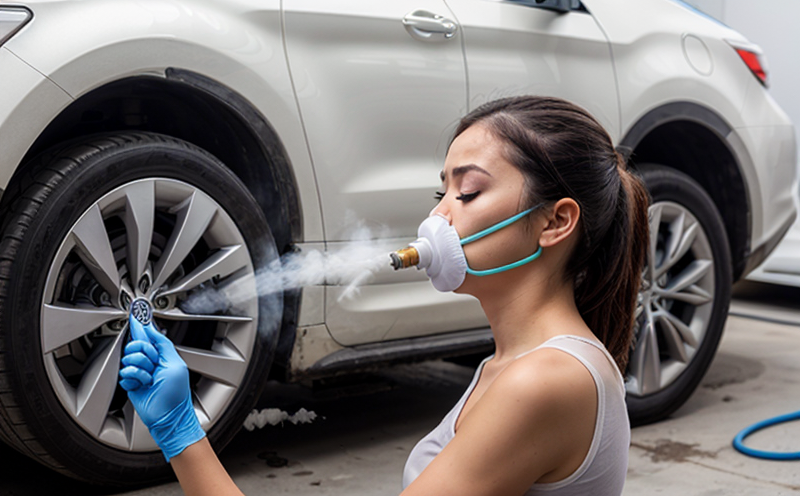ASTM D7550 VOC Emission Testing in Coatings
The American Society for Testing and Materials (ASTM) standard D7550-16 provides a precise method to determine the volatile organic compound (VOC) emissions from coatings during their use. This testing is critical for ensuring compliance with environmental regulations, enhancing product quality, and safeguarding human health and safety. In this detailed service page, we delve into the intricacies of ASTM D7550 VOC emission testing in coatings.
The primary goal of this test is to quantify the amount of VOCs released by a coating under controlled conditions that mimic real-world usage scenarios. This information is essential for manufacturers and consumers alike, as it helps in selecting products that meet stringent environmental standards while offering superior performance. The test covers both solvent-based and waterborne coatings, providing insights into their potential contribution to indoor air quality.
The testing procedure involves placing the coating on a substrate, curing it according to manufacturer specifications, and then conducting the emission test using an environmental chamber or similar apparatus. The emissions are measured over time, typically for 28 days, to capture all significant VOC releases. Compliance with this standard ensures that coatings meet the stringent limits set by regulatory bodies such as the U.S. Environmental Protection Agency (EPA) under Title VI regulations.
The results of ASTM D7550 testing are used in various ways across industries. For example, quality managers use these data to ensure their products comply with international standards like ISO 13468 or local legislation such as the European Union’s REACH regulation. Compliance officers rely on this information to avoid legal penalties and maintain a positive corporate reputation. R&D engineers benefit from ASTM D7550 testing by identifying areas for improvement in formula design, reducing VOC content without sacrificing product performance.
Waterborne coatings are particularly scrutinized under ASTM D7550 due to their growing popularity as more environmentally friendly alternatives to solvent-based paints. By meeting the stringent requirements of this test, manufacturers can claim compliance with leading environmental certification programs such as Green Seal or Leadership in Energy and Environmental Design (LEED).
Applied Standards
The ASTM D7550 VOC emission testing method is based on the principles outlined in ASTM E1648-03, which provides a comprehensive framework for evaluating volatile organic compounds from coatings. This standard ensures consistent and reliable results across different laboratories, enhancing confidence in the test outcomes.
The key parameters measured during ASTM D7550 testing include total VOC content (g/L) and individual VOC species concentrations. Compliance is determined by comparing these values against the specified limits set forth in ASTM D7550-16. For example, if a coating contains more than 2 g/L of total VOCs, it would fail to meet the standard.
Other relevant standards include ISO 13468, which provides guidelines for measuring indoor air quality in buildings containing materials like coatings, and EN 773-5, which specifies requirements for solvent-borne paints. By adhering to these international standards, laboratories can offer clients a comprehensive service that meets global expectations.
The testing apparatus used must comply with the specifications set by ASTM D7550 itself, ensuring accurate and reproducible measurements. Key components include environmental chambers capable of maintaining precise temperature and humidity conditions, gas analyzers for detecting VOC concentrations, and data recording systems to document test results over time.
Industry Applications
- Manufacturing: Ensures that all products meet stringent environmental regulations, enhancing corporate social responsibility efforts.
- R&D: Identifies opportunities for improving coating formulations while minimizing VOC emissions.
- Sales & Marketing: Provides data to support marketing claims about the eco-friendliness of products.
In addition to these primary applications, ASTM D7550 VOC emission testing in coatings plays a crucial role in meeting regulatory requirements. For instance, many countries have implemented regulations limiting the amount of VOCs allowed in consumer goods. By undergoing this testing process, manufacturers can ensure their products remain compliant with such laws.
Another important application is in research and development departments where scientists are continuously striving to develop new coatings that not only perform well but also contribute positively to environmental sustainability goals.
Use Cases and Application Examples
- Residential Paints: Ensuring that paints used in homes do not emit excessive levels of VOCs, which can cause health issues when inhaled over extended periods.
- Automotive Coatings: Verifying the emissions from automotive finishes to ensure they comply with stringent environmental regulations worldwide.
- Furniture Finishes: Providing data needed for manufacturers to produce furniture that meets indoor air quality standards and contributes positively to public health.
In addition to these specific examples, ASTM D7550 VOC emission testing in coatings is also applicable in various other sectors, including construction materials, industrial finishes, and maintenance paints. These tests help stakeholders across different industries make informed decisions about the environmental impact of their products while maintaining high standards of performance.





